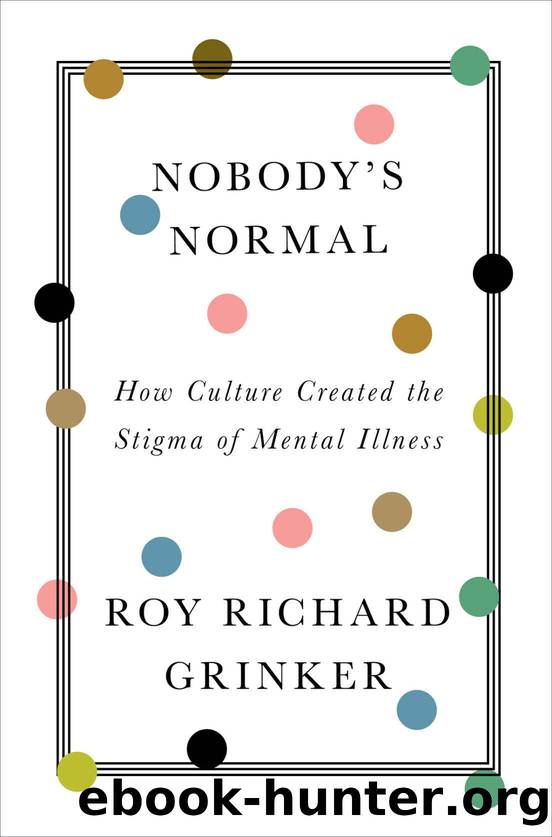Nobody's Normal: How Culture Created the Stigma of Mental Illness by Roy R. Grinker

Author:Roy R. Grinker [Grinker, Roy R.]
Language: eng
Format: azw3
Publisher: W. W. Norton & Company
Published: 2021-01-26T00:00:00+00:00
CHAPTER 13
AN ILLNESS LIKE ANY OTHER?
âDepression is a cold of the heartâ (âKokoro no kazeâ).
PsychoDoctor, Japanese television drama (2002)
Beginning in the 1980s, pharmaceutical companies, mental health advocates, the US governmentâs National Institutes of Health, and researchers and clinicians throughout the world formed what the writer Robert Whitaker calls a four-part harmony, a âpowerful quartet of voicesâ to convince the public of the biological nature of mental disorders.1 They all agreed that stigma could be reduced only if people understood that mental illnesses were diseases of the brain, not of character.
Yet biological models of mental illness have been central to the stigmatization of mental illnesses. Whereas the DSM-I and DSM-II conceptualized mental illnesses as emotional reactions to oneâs environmentâoften quite appropriate reactions, like having anxiety in combat or grief after the death of a loved oneâin 1980 the DSM-III redefined mental illnesses in more scientific terms. In the DSM-III, mental illnesses were distinct clinical conditions essential to a particular kind of person, disorders that doctors could measure, reliably diagnose, associate with certain demographic groups, and attempt to treat with medications. Someone with a psychosis was now âa schizophrenicâ; someone with depression was âa depressive.â And thatâs exactly what stigma is about: when a diagnosis comes to represent a person as a whole.2 To counter the risk of stigma, most of the clinicians I know thus tend to say that someone has schizophrenia or depression, not that they are a schizophrenic or a depressive. But the rest of society doesnât necessarily heed this linguistic detail.
Many experts reasoned that if mental illnesses could be conceived of as medical conditions they would be less likely to define oneâs personhood. This is why British doctors rejoiced when, in the 1960s, they discovered that the confusion and hallucinations of the mad king, King George III, had been caused not by a mental illness of unknown cause but by the metabolic disorder called porphyria. They declared: âFinally, by implication this diagnosis clears the House of Hanover of an hereditary taint of madness.â3 In 1984, in an attempt to reduce stigma, psychiatrist Nancy Andreasen called mental illness a âbroken brain.â Someone with a broken arm or leg wouldnât think of staying away from a doctor, but someone with a serious mental illness does. Andreasen argued that prejudice and discrimination of people with mental illnesses derived from ignorance, âfrom a failure to realize that mental illness is a physical illness, an illness caused by biological forces and not by moral turpitude.â4
Social scientists often call this desire to comprehend humanity in medical terms medicalization. Medicalization has its roots in the Enlightenment, in secularism, science, and the drive to make material those aspects of human experienceâlike the spirit, the mind, and the personalityâthat used to be immaterial. Medicalization is the process of turning previously nonmedical problems into medical ones, as when people think about childbirth as a sickness that requires admission to the maternity ward of a hospital or when they take medicines for menopause. Privileging the body over the mind,
Download
This site does not store any files on its server. We only index and link to content provided by other sites. Please contact the content providers to delete copyright contents if any and email us, we'll remove relevant links or contents immediately.
| Anthropology | Archaeology |
| Philosophy | Politics & Government |
| Social Sciences | Sociology |
| Women's Studies |
The Leavers by Lisa Ko(6469)
Born to Run: by Christopher McDougall(6258)
iGen by Jean M. Twenge(4702)
Sapiens by Yuval Noah Harari(4534)
The Kite Runner by Khaled Hosseini(4429)
Spare by Prince Harry The Duke of Sussex(4195)
Bullshit Jobs by David Graeber(3178)
Livewired by David Eagleman(3121)
Goodbye Paradise(2957)
Never by Ken Follett(2877)
A Dictionary of Sociology by Unknown(2516)
Harry Potter 4 - Harry Potter and The Goblet of Fire by J.K.Rowling(2416)
The Club by A.L. Brooks(2356)
People of the Earth: An Introduction to World Prehistory by Dr. Brian Fagan & Nadia Durrani(2346)
The Social Psychology of Inequality by Unknown(2308)
Machine Learning at Scale with H2O by Gregory Keys | David Whiting(2281)
Harry Potter and the Order of the Phoenix (5) by J.K. Rowling(2226)
0041152001443424520 .pdf by Unknown(2218)
Don't Sleep, There Are Snakes by Daniel L. Everett(2216)
